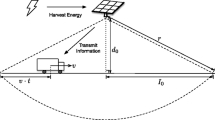Abstract
Mobile wireless sensor networks (MWSNs) have emerged as a promising data gathering paradigm for animal preservation. In MWSNs, it is challenging to efficiently transmit data between resource-constrained mobile sensor nodes and static gateway nodes because of its unreliable and unpredictable nature. Further, elaborate statistics must be known in advance to properly decide when packets should be transmitted, and how many of them to transmit. However, mobility of targets, and instability and intermittency of wireless connections make the system difficult to control. In this paper, we propose EETC, an optimal Energy-Efficient Transmission Control strategy for MWSNs, to deal with the problem based on Lyapunov optimization. EETC comprises two steps: (1) network status collection: collecting, by way of probing messages and acknowledgement messages, information about quality of connectivity and queue backlog; (2) decision making: the mobile sensor node decides on the number of packets that should be transmitted. Our simulation results and analysis demonstrated the performance and robustness of EETC.













Similar content being viewed by others
References
Schwiebert, L., Gupta, S., & Weinmann, J. (2001). Research challenges in wireless networks of biomedical sensors. In ACM MobiCom (pp. 151–165).
Brooks, B., Ramanathan, P., & Sayeed, A. (2003). Distributed target classification and tracking in sensor networks. Proceeding of the IEEE, 91(8), 1163–1171.
Cerpa, A., Elson, J., Hamilton, M., & Zhao, J. (2001). Habitat monitoring: Application drive for wireless communications technology. In ACM SIGCOMM computer communication review workshop on data communication in Latin America and the Caribbean (pp. 20–41).
Mainwaring, A., Polastre, J., Szewczyk, R., Culler, D., & Anderson, J. (2002). Wireless sensor networks for habitat monitoring. ACM WSNA (pp. 88–97).
Zhang, P., Sadler, C., Lyon, S., & Martonosi, M. (2004). Hardware design experiences in zebranet. ACM SenSys (pp. 227–238).
Anastasi, G., Conti, M., Francesco, M., & Passarella, A. (2009). Energy conservation in wireless sensor networks. Ad Hoc Networks, 7(3), 537–568.
Luo, J., & Hubaux, J. (2005). Joint mobility and routing for lifetime elongation in wireless sensor networks. IEEE INFOCOM (pp. 1735–1746).
Neely, M. (2006). Energy optimal control for time-varying wireless networks. IEEE Transactions on Information Theory, 52(7), 2915–2934.
Ciullo, D., Celik, G., & Modiano, E. (2010). Minimizing transmission energy in sensor networks via trajectory control. In IEEE 8th international symposium on modeling and optimization in mobile, ad hoc and wireless networks (WiOpt) (pp. 132–141).
Ahmad, A., Jabbar, S., Paul, A., & Rho, S. (2014). Mobility aware energy efficient congestion control in mobile wireless sensor network. International Journal of Distributed Sensor Networks, 2014, 1–13.
Bijarbooneh, F., Du, W., Ngai, E., & Fu, X. (2014). Energy-efficient sensor selection for data quality and load balancing in wireless sensor networks. In International symposium on quality of service (pp. 1–6).
Georgiadis, L., Neely, M., & Tassiulas, L. (2006). Resource allocation and cross-layer control in wireless networks. Foundation and Trends in Networking, 1(1), 1–144.
Song, Y., & Fang, Y. (2010). Cross-layer interactions in multihop wireless sensor networks: A constrained queueing model. ACM Transactions on Modeling and Computer Simulation, 21(1), 4–25.
Neely, M. (2010). Stochastic network optimization with application to communication and queueing systems. New Jersey: Morgan & Claypool Publishers.
Neely, M. (2011). Opportunistic scheduling with worst case delay guarantees in single and multi-hop networks. IEEE INFOCOM (pp. 1728–1736).
Huang, L. (2013). Optimal sleep-wake scheduling for energy harvesting smart mobile devices. In 2013 International symposium and workshops on modeling and optimization in mobile, ad hoc and wireless networks (pp. 484–491).
Neely, M. (2014). Distributed stochastic optimization via correlated scheduling. IEEE INFOCOM (pp. 2418–2426).
Fang, W., Li, Y., Zhang, H., & Xiong, N. (2014). On the throughput-energy tradeoff for data transmission between cloud and mobile devices. Elsevier Information Science, 283, 79–93.
Zafer, M., & Modiano, E. (2005). A calsulus approach to minimum energy transmission policies with quality of service guarantees. IEEE INFOCOM (pp. 548–559).
Uysal-Biyikoglu, E., Prabhakar, B., & Gamal, A. (2002). Energy-efficient packet transmission over a wireless link. IEEE /ACM Transactions on Networking, 10(4), 487–499.
Chen, W., Neely, M., & Mitra, U. (2008). Energy-efficient transmission with individual packet delay constraints. IEEE Transactions on Information Theory, 54(5), 2090–2109.
Le, L., Modiano, E., & Shroff, N. (2010). Optimal control of wireless networks with finite buffers. IEEE INFOCOM (pp. 1316–1329).
Ying, L., Shakkottai, S., Reddy, A., & Liu, S. (2011). On combining shortestpath and back-pressure routing over multihop wireless networks. IEEE/ACM Transaction on Networking, 19(3), 841–854.
Toulabi, M., & Javadi, S. (2013). Energy-saving in wireless sensor networks based on sink movement control using fuzzy logic. Journal of Wireless Sensor Network, 1(1), 1–7.
Zamalloa, M., & Krishnamachari, B. (2007). An analysis of unreliability and asymmetry in low-power wireless links. ACM Transactions on Sensor Networks, 3(2), 1–34.
Estrin, D. (2002). Tutorial wireless sensor networks part iv: Sensor network protocols. In ACM MobiCom.
Acknowledgments
This work was supported in part by NSFC under Grant Nos. 61202393 and 61170218, National Key Technology R&D Program of the Ministry of S&T of China under Grant Nos. 2013BAK01B02 and 2013BAK01B05, the Key Science and Technology Program of Shaanxi Province under Grant No. 2011K06-07, Educational Commission of Shaanxi Province, China under Grant No. 2011JG06, the Planned Science and Technology Program of Shaanxi Province under Grant No. 2011K06-09, the CPSF under Grant No. 2012M521797, the International Cooperation Foundation of Shaanxi Province, China under Grant No. 2013KW01-02, and the International Postdoctoral Exchange Fellowship Program 2013 under Grant No. 57 funded by the office of China Postdoctoral Council.
Author information
Authors and Affiliations
Corresponding author
Rights and permissions
About this article
Cite this article
Yin, X., Fang, D., Wang, W. et al. EETC: to transmit or not to transmit in mobile wireless sensor networks. Wireless Netw 22, 635–646 (2016). https://doi.org/10.1007/s11276-015-0989-x
Published:
Issue Date:
DOI: https://doi.org/10.1007/s11276-015-0989-x




